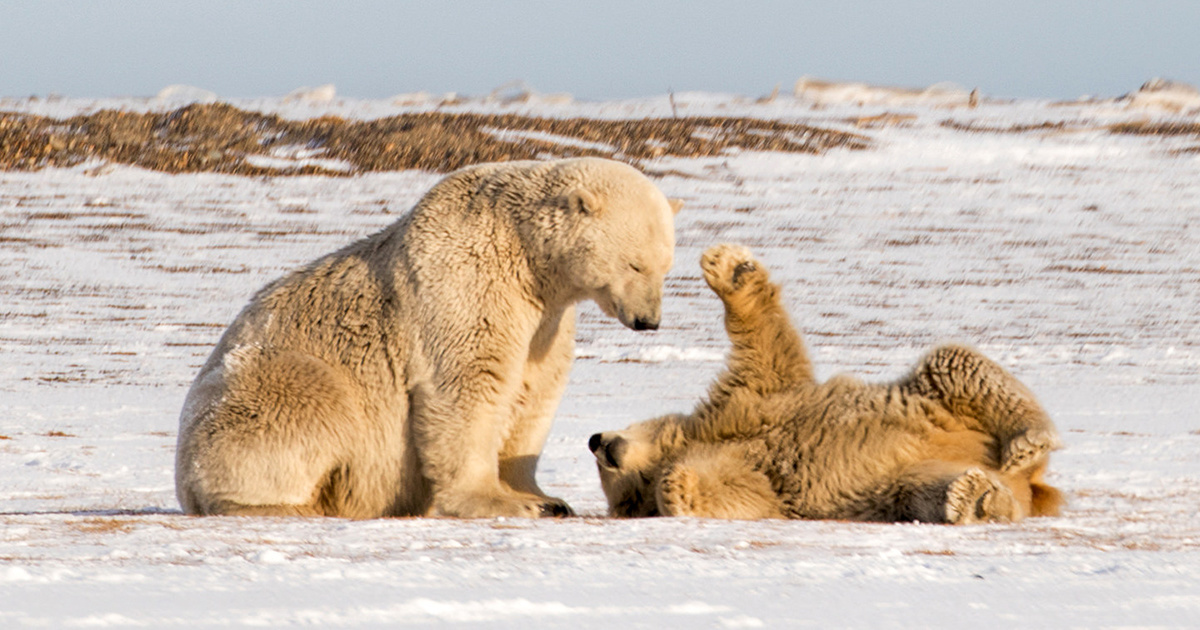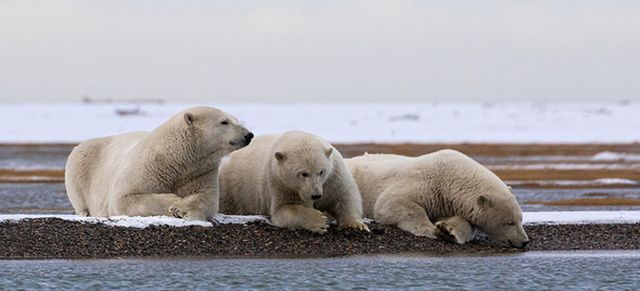
Arctic Refuge Oil Surveys Put Polar Bears in the Crosshairs

By Rebecca Bowe
Send an army of industry workers into remote polar bear territory in the dead of winter, and things are not going to end well.
Yet that’s just what the Trump administration would open the door to as it prepares for oil and gas drilling and moves to authorize seismic testing, a precursor to drilling in the Arctic Refuge.
Earthjustice has long worked to defend the Arctic Refuge, which now faces the greatest threat in decades as the Trump administration barrels forward with plans for an oil and gas lease sale as early as next year. Members of the public have until Feb. 11 to comment on a draft plan to hold a lease sale.
Congress opened the coastal plain of the Arctic Refuge to industry leasing for the first time ever in December of 2017, by tacking a drilling provision onto a federal tax bill to avoid a filibuster. Most Americans are against drilling in the Arctic Refuge because the wilderness has extraordinary ecological value that warrants the highest safeguards. Bipartisan opposition has historically prevented industry from harming this cherished landscape.
Polar bears on the coastal plain will be especially vulnerable to harm from seismic operations and drilling. Proposed oil exploration activities pose substantial risks of death or serious injury to denning mother and cub polar bears, according to the analysis of Dr. Steven Amstrup, chief scientist for Polar Bears International. Polar bears, classified as marine mammals, are already struggling. Sea ice is vanishing, a consequence of warmer winter temperatures, and polar bears cannot survive without it. According to the U.S. Geological Survey, reduced sea ice could result in the loss of approximately two-thirds of the world’s polar bears within 50 years. The agency predicts Alaska’s polar bears will be “extirpated under current emission scenarios”—which means they will go extinct if nothing is done to address climate change.
Scientists refer to the polar bears that live in the Arctic National Wildlife Refuge as the Southern Beaufort Sea population. The coastal plain, the specific area of the Refuge where the fossil fuel industry envisions setting up oil-drilling equipment, is an important polar bear denning area.
The Southern Beaufort Sea population has declined by approximately 40 percent in recent years, which has made it more important than ever that the bears can successfully birth and raise young. As ice melts away, polar bear mothers are increasingly going on land, to the coastal plain, to build their dens—and they are particularly vulnerable to disturbance while denning. The combination of having more polar bears on shore and more people conducting seismic testing operations means there will be more interactions between people and bears, resulting in greater risks to bears.
Polar Bears in the wild Arctic off the north slope of Alaska, near Kaktovik on Barter Islandcheryl strahl / Flickr
Enter SAExploration, a private oil-industry outfit that submitted an application to conduct seismic testing on the coastal plain. Working 24 hours a day for months on end, this company envisions sending work crews of 150 people or more into this polar bear territory to map out oil and gas reserves. It would navigate 90,000-pound vehicles in a grid pattern across the landscape, sending vibrations into the ground and carving lasting impressions into the tundra. The crews would consume an estimated 6,000 to 7,000 gallons of fuel per day. An incinerator would burn garbage waste on site.
SAE has submitted a petition to the federal government for “incidental take authorization” for polar bears. The word “take,” as defined under the Marine Mammal Protection Act, means “to harass, hunt, capture, or kill” a protected species.
According to Dr. Amstrup of Polar Bears International, SAE’s proposal could bring deadly consequences. Amstrup warned in a letter to the Bureau of Land Management:
“Lethal disturbances are likely when a heavy vehicle actually runs over a den … On average, if there are 11 undetected bear dens on the refuge, a seismic survey like that proposed by SAE has a 25 percent chance that at least one polar bear will be killed when a heavy vehicle runs over it. Less lethal disturbances are likely when heavy vehicles pass … [nearby] a den.”
Amstrup notes that even with the use of infrared surveys to mark the location of polar bear dens, as many as half of the occupied dens will go undetected across the vast landscape. The scientist concludes:
“It is virtually certain that most undetected polar bears in their dens will be disturbed at some level.”
There are many good reasons to oppose oil and gas industrialization in the Arctic National Wildlife Refuge. It would destroy one of the last truly intact wilderness areas on Earth, an open expanse of public lands that for decades remained off-limits to drilling precisely because Congress recognized its extraordinary value. Greenhouse gas emissions from extracting and burning Arctic Refuge oil reserves would worsen global climate change, making life worse for future generations. It would also disrupt migrating caribou, in turn violating the human rights of indigenous Gwich’in people who rely on caribou as a primary food source.
“Earthjustice is fighting Trump’s headlong rush to consign the coastal plain to large-scale industrial oil activities,” said Anchorage-based Earthjustice attorney Erik Grafe. “As we speak, the administration is on course to permit seismic testing as early as this winter without legitimate environmental review and without even identifying what law it thinks authorizes this activity.”
As the Trump administration and its friends in the oil sector prepare to shatter the wintry silence of the Arctic Refuge with major industrial operations in just a few months’ time, the threat to endangered polar bears speaks volumes about the current administration’s disregard for wildlife and the public lands we all cherish.
#Trump Administration Sued Over Controversial #Arctic Drilling Project https://t.co/yFj74Sn62x @peoplevsoil @CenterForBioDiv @Defenders
— EcoWatch (@EcoWatch) December 18, 2018
Rebecca Bowe is the communications strategist for Earthjustice’s Northwest and Alaska regional offices.

 233k
233k  41k
41k  Subscribe
Subscribe 
